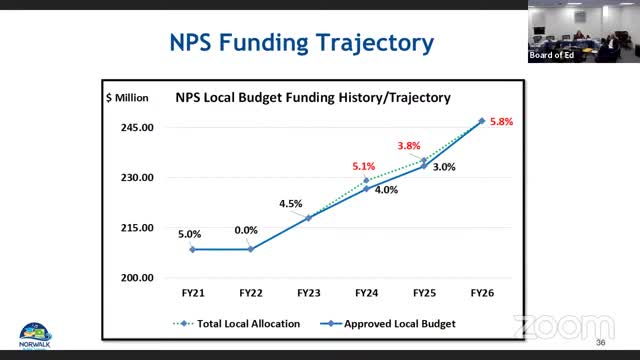Budget pressures mount as costs for services soar
October 09, 2024 | Norwalk School District, School Districts, Connecticut
This article was created by AI summarizing key points discussed. AI makes mistakes, so for full details and context, please refer to the video of the full meeting. Please report any errors so we can fix them. Report an error »

During a recent government meeting, officials discussed the rising costs associated with essential services such as police and fire protection, emphasizing that these expenses cannot be solely tied to population growth. One speaker highlighted the flawed logic of assuming that a stable student population should result in unchanged school operational costs, drawing parallels to city budgets that remain flat despite increasing service demands.
The discussion underscored the impact of inflation and rising utility costs on the budget, with officials noting that residents are likely feeling these increases in their own households. They pointed out that collective bargaining agreements contribute to annual salary and wage increases of approximately 2.5 to 3 percent, not accounting for fluctuating insurance costs.
Additionally, the meeting addressed the capital budget, which includes expenditures for items valued over $10,000 with a useful life of two to three years. Officials noted that many capital requests recur annually, such as the ongoing need for band and string instruments, which have been requested at a rate of 300 each year for the past two years. As the budget planning for the next year begins, officials will consult with the curriculum team to determine any new requests.
The meeting highlighted the complexities of budgeting for public services, stressing the need for a comprehensive understanding of cost drivers beyond mere population statistics.
The discussion underscored the impact of inflation and rising utility costs on the budget, with officials noting that residents are likely feeling these increases in their own households. They pointed out that collective bargaining agreements contribute to annual salary and wage increases of approximately 2.5 to 3 percent, not accounting for fluctuating insurance costs.
Additionally, the meeting addressed the capital budget, which includes expenditures for items valued over $10,000 with a useful life of two to three years. Officials noted that many capital requests recur annually, such as the ongoing need for band and string instruments, which have been requested at a rate of 300 each year for the past two years. As the budget planning for the next year begins, officials will consult with the curriculum team to determine any new requests.
The meeting highlighted the complexities of budgeting for public services, stressing the need for a comprehensive understanding of cost drivers beyond mere population statistics.
View full meeting
This article is based on a recent meeting—watch the full video and explore the complete transcript for deeper insights into the discussion.
View full meeting
